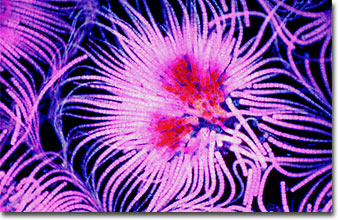Spike (M.I.) Walker
Cyanobacterium (Gleotrichia echinulata)
English photomicrographer Spike (M.I.) Walker has been a consistent winner of the Nikon Small World competition for many years and has published many articles and a book about microscopy. Featured below is a photomicrograph of a familiar cyanobacterium found in many lakes and reservoirs.

|
Gleotrichia echinulata is a familiar fresh water cyanobacterium found in lakes and reservoirs, where its pompon-like colonies can form thick blooms. The photomicrograph presented above was taken with a planapochromatic 25x/0.65 NA objective coupled to an oil-immersion darkfield condenser. Illumination (low wavelength ultraviolet fluorescence) was provided by an HBO 200-watt mercury vapor arc lamp with a UG5 excitation filter. The microscope was a Zeiss Ultraphot III with a automatic 35-millimeter photohead. The film was Fujichrome Velvia. (63x) |
The name for the genus Gleotrichia (or Gloeotrichia) comes from the Greek for "gelatinous hair," an appropriate descriptive for these filamentous organisms. Clusters of Gleotrichia taper to fine points or hairs, called trichomes, which gives the colony its hairlike appearance. G. echinulata belongs to the order Oscillatoriales of cyanobacteria, also known as the blue-green algae. Gleotrichia is found in freshwater lakes and ponds and often plagues pond and aquarium keepers when elevated phosphate levels encourage excessive growth.
Cyanobacteria are one of the oldest, largest, and most important groups of bacteria on Earth. While the oldest known fossils of these organisms are more than 3.5 billion years old, they are still very common and essential to life on planet Earth. These were the first organisms to produce oxygen via photosynthesis and the first nitrogen fixing organisms -- transforming the gaseous nitrogen of the air into compounds that can be used by living cells. Cyanobacteria thrive in some of the most inhospitable environments known, occurring in hot springs, underneath ice packs, and on the lower surfaces of rocks in deserts. They are among the first organisms to colonize bare rock and soil.
Although most cyanobacteria are obligate phototrophs and will not grow in the absence of light, some can grow in the dark if there is a sufficient supply of glucose to provide carbon and energy. Cyanobacteria contain only one form of chlorophyll, chlorophyll a, a green pigment. In addition, they contain various yellowish carotenoids, the blue pigment phycobilin, and, in some species, the red pigment phycoerythrin. The combination of phycobilin and chlorophyll produces the characteristic blue-green color from which these organisms derive their popular name. Other pigments can color some species green, brown, yellow, black, or red.
